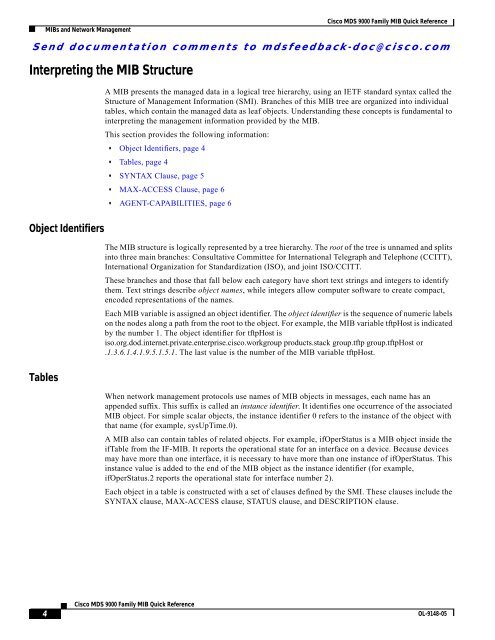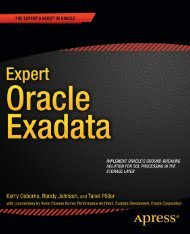Cisco MDS 9000 Family MIB Quick Reference.pdf
Cisco MDS 9000 Family MIB Quick Reference.pdf
Cisco MDS 9000 Family MIB Quick Reference.pdf
Create successful ePaper yourself
Turn your PDF publications into a flip-book with our unique Google optimized e-Paper software.
<strong>MIB</strong>s and Network Management<br />
<strong>Cisco</strong> <strong>MDS</strong> <strong>9000</strong> <strong>Family</strong> <strong>MIB</strong> <strong>Quick</strong> <strong>Reference</strong><br />
Send documentation comments to mdsfeedback-doc@cisco.com<br />
Interpreting the <strong>MIB</strong> Structure<br />
Object Identifiers<br />
Tables<br />
A <strong>MIB</strong> presents the managed data in a logical tree hierarchy, using an IETF standard syntax called the<br />
Structure of Management Information (SMI). Branches of this <strong>MIB</strong> tree are organized into individual<br />
tables, which contain the managed data as leaf objects. Understanding these concepts is fundamental to<br />
interpreting the management information provided by the <strong>MIB</strong>.<br />
This section provides the following information:<br />
• Object Identifiers, page 4<br />
• Tables, page 4<br />
• SYNTAX Clause, page 5<br />
• MAX-ACCESS Clause, page 6<br />
• AGENT-CAPABILITIES, page 6<br />
The <strong>MIB</strong> structure is logically represented by a tree hierarchy. The root of the tree is unnamed and splits<br />
into three main branches: Consultative Committee for International Telegraph and Telephone (CCITT),<br />
International Organization for Standardization (ISO), and joint ISO/CCITT.<br />
These branches and those that fall below each category have short text strings and integers to identify<br />
them. Text strings describe object names, while integers allow computer software to create compact,<br />
encoded representations of the names.<br />
Each <strong>MIB</strong> variable is assigned an object identifier. The object identifier is the sequence of numeric labels<br />
on the nodes along a path from the root to the object. For example, the <strong>MIB</strong> variable tftpHost is indicated<br />
by the number 1. The object identifier for tftpHost is<br />
iso.org.dod.internet.private.enterprise.cisco.workgroup products.stack group.tftp group.tftpHost or<br />
.1.3.6.1.4.1.9.5.1.5.1. The last value is the number of the <strong>MIB</strong> variable tftpHost.<br />
When network management protocols use names of <strong>MIB</strong> objects in messages, each name has an<br />
appended suffix. This suffix is called an instance identifier. It identifies one occurrence of the associated<br />
<strong>MIB</strong> object. For simple scalar objects, the instance identifier 0 refers to the instance of the object with<br />
that name (for example, sysUpTime.0).<br />
A <strong>MIB</strong> also can contain tables of related objects. For example, ifOperStatus is a <strong>MIB</strong> object inside the<br />
ifTable from the IF-<strong>MIB</strong>. It reports the operational state for an interface on a device. Because devices<br />
may have more than one interface, it is necessary to have more than one instance of ifOperStatus. This<br />
instance value is added to the end of the <strong>MIB</strong> object as the instance identifier (for example,<br />
ifOperStatus.2 reports the operational state for interface number 2).<br />
Each object in a table is constructed with a set of clauses defined by the SMI. These clauses include the<br />
SYNTAX clause, MAX-ACCESS clause, STATUS clause, and DESCRIPTION clause.<br />
4<br />
<strong>Cisco</strong> <strong>MDS</strong> <strong>9000</strong> <strong>Family</strong> <strong>MIB</strong> <strong>Quick</strong> <strong>Reference</strong><br />
OL-9148-05











